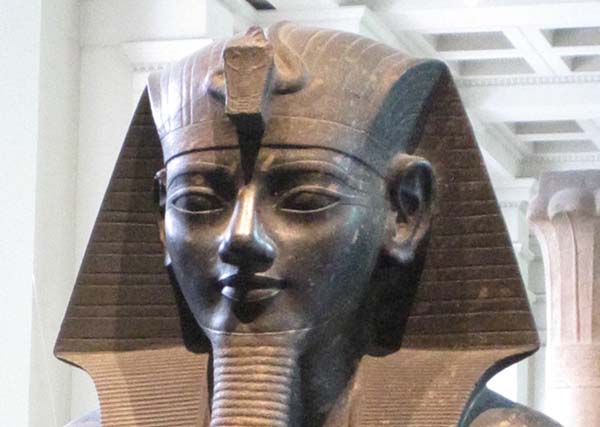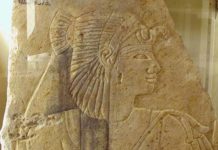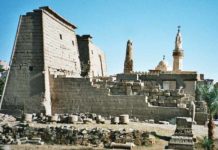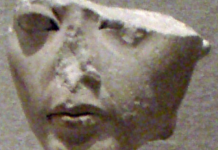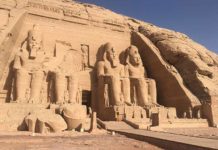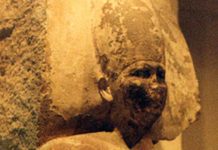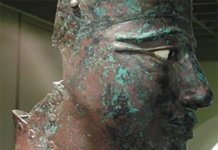Amenhotep was insecure with regards to his heritage and embellished a divine ancestry for himself and in turn venerated his mother as The Chosen One of Amun
Historians and archaeologists have different opinions as to whether or not Mutemwiya acted as a regent for Amenhotep during his youth. However, at the Tomb of Heqareshu – his tutor and guardian, the young Amenhotep is shown enthroned beneath a canopy and wearing the crown, and behind him stands his mother with her hand on his shoulder – which appears to indicate her guidance, and it is possible that she did indeed act as a regent until her son had reached maturity.
The Divine Birth of Amenhotep III
As a king born of a lesser-ranking wife – Amenhotep was certainly self-conscious and felt the need to secure his position as king. Mutemwiya who was forever in the shadows of the court of her late husband, was now given the coveted title of a Great Royal Wife in the same way that his father – Tuthmosis IV had given to his own mother, Queen Tiaa.
But this was not enough for Amenhotep and he went about to embellish a legend concerning his own conception, and he had it engraved on the walls of The Birth Chamber in the Temple of Amun at Luxor. The scene depicts the state-god Amun, who assumes the form of Tuthmosis and visits Mutemwiya during her sleep.
The divine presence of Amun awakens her, and they engage in sexual activities together. The scenes declare Mutemwiya to be The Chosen one of Amun and in later scenes throughout the narration she is led by the goddess Hathor to give birth to Amenhotep, the future king, in the presence of the gods – and thus establishing a divine ancestry for himself.
During the reign of Amenhotep III, Egypt entered into a glorious age of military triumph and grandiose construction works – which all depict images of the royal family. At the Karnak Temple, Amenhotep commissioned a black granite sculpture of a barque with an inscription spelling out Mutemwiya – which means Mut is in her Barque, in honour of both his mother, and the goddess Mut – this is now housed in the British Museum in London.
Mutemwiya held many titles including God’s Wife, Great King’s Wife – which were only used after her husband’s death, Hereditary Princess, Mistress of Upper and Lower Egypt, God’s Mother and King’s Mother. Cyril Aldred has also suggested that she was a direct descendant of Queen Ahmose-Nefertari – the founding ancestress of the 18th Dynasty who could bestow hereditary titles to her female descendants – who in turn became hereditary princesses. However, this is not certain and it may have simply been a symbolic title.
Mutemwiya lived almost until the end of her son’s thirty-eight year reign, just like Yuya and Tjuya – the parents of her daughter-in-law, Queen Tiye, and she had several grandchildren including, Princesses Sitamun, Isis, Henuttaneb, Nebetah and Beketaten – (who may have had a different name at the time of her birth), and Princes Tuthmosis and Amenhotep (who late ruled as Akhenaten).
Queens of Egypt under King Amenhotep III
It appears that Amenhotep wanted to venerate the women in his family, and at the time of his 30th Jubilee he took his own daughter, Sitamun as a Great Royal Wife – the union which was probably in honour of the relationships of the goddess Hathor, was probably more ceremonial than sexual – giving Egypt her third generation of royal women.
The Colossi of Memnon features the king with three generations of 18th Dynasty Egyptian queens, Mutemwiya, Tiye and Sitamun – which would have been engraved around the year 1358 BC – at the time of the 30th Jubilee, and the three women would have ruled with all ceremonial and religious honours from the palace at Thebes.
Mutemwiya probably died between Year 30 and Year 34 of her son’s reign, because in Year 34 he took his second daughter Isis as a Great Royal Wife. The aged queen therefore died at some point between 1358 and 1354 BC – and was certainly over the age of sixty, and may have been as old as seventy. Her tomb and her mummy have so far never been discovered.
She was the great-grandmother of Queen Aknhesenamun, and the double-great-grandmother of Tutankhamun.
Sources:
- Akhenaten by Cyril Aldred, Thames & Hudson Ltd, 1991
- Egypt’s Sun King: Amenhotep III by Joann Fletcher, Duncan Baird Publishers, 2000
- Tutankhamun by Christine Desroches-Noblecourt, Penguin Books, 1965


